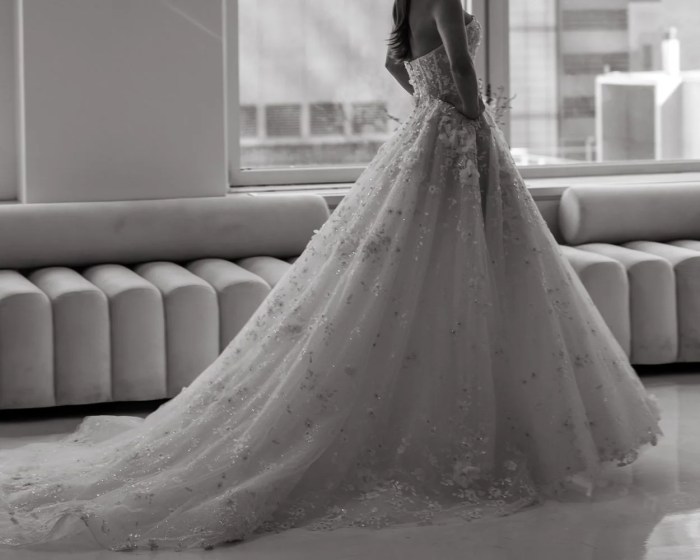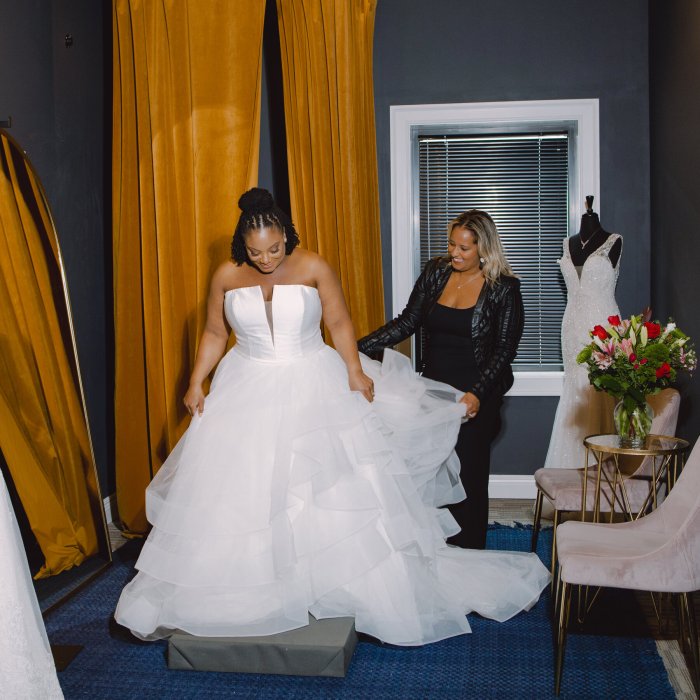Wedding Dress Styles
Show me a picture of wedding dresses – Choosing a wedding dress is a significant decision, influenced by personal style and the overall wedding theme. Understanding different styles is crucial for finding the perfect fit. This section will explore several popular wedding dress styles, highlighting their key characteristics and differences.
A-Line Wedding Dresses
A-line wedding dresses are characterized by their fitted bodice that gradually flares out from the waist, resembling the letter “A.” This silhouette is universally flattering, suitable for various body types. The gentle flare allows for ease of movement while maintaining a sophisticated look. Common fabrics include satin, chiffon, and lace.
Ballgown vs. Mermaid Wedding Dresses
Ballgown and mermaid wedding dresses represent contrasting silhouettes. Ballgowns feature a fitted bodice and a full, voluminous skirt, creating a dramatic and princess-like effect. Mermaid dresses, on the other hand, hug the body closely from the shoulders to the knees or mid-thigh, then flare out dramatically, resembling a fishtail. Ballgowns often suit more formal settings, while mermaid dresses offer a more modern and figure-hugging look.
Both styles can be made from a variety of fabrics, from luxurious silks to lighter tulle.
Sheath vs. Empire Waist Wedding Dresses
Sheath and empire waist dresses differ primarily in their waistline placement. Sheath dresses are fitted from the shoulders to the hem, creating a sleek and streamlined silhouette. Empire waist dresses feature a high waistline, typically just below the bust, with a flowing skirt that falls loosely from there. Sheath dresses often exude sophistication and modernity, while empire waist dresses offer a romantic and comfortable fit, particularly for expectant mothers.
Bohemian and Vintage-Inspired Wedding Dresses
Bohemian and vintage-inspired wedding dresses offer distinct aesthetics. Bohemian dresses often feature flowing fabrics like lace, chiffon, or silk, with details like embroidery, tassels, or floral appliqués. They tend to have relaxed silhouettes and a carefree vibe. Vintage-inspired dresses draw inspiration from bygone eras, incorporating elements like lace, beading, and specific silhouettes popular in those periods (e.g., the 1920s flapper dress or the 1950s full skirt).
These dresses often evoke a sense of nostalgia and elegance.
Wedding Dress Styles Table
| Style | Silhouette | Key Features | Suitable Body Types |
|---|---|---|---|
| A-Line | Fitted bodice, gradually flaring skirt | Flattering, versatile, comfortable | Most body types |
| Ballgown | Fitted bodice, full skirt | Dramatic, princess-like | Most body types, especially those wanting to emphasize the waist |
| Mermaid | Fitted bodice and skirt to mid-thigh/knee, then flares | Figure-hugging, modern | Hourglass, pear, and athletic figures |
| Sheath | Fitted from shoulders to hem | Sleek, sophisticated | Slender figures |
| Empire Waist | High waistline, flowing skirt | Romantic, comfortable | Most body types, especially expectant mothers |
| Bohemian | Flowing fabrics, relaxed silhouette | Free-spirited, relaxed | Most body types |
| Vintage-Inspired | Varied, depending on era | Nostalgic, elegant | Most body types |
Fabric and Materials
The fabric chosen significantly impacts the drape, texture, and overall feel of a wedding dress. This section will explore various fabrics commonly used, comparing their properties and suitability for different styles and preferences.
Fabric Descriptions and Comparisons
Several fabrics are popular choices for wedding dresses, each with unique properties. Satin is known for its luxurious sheen and smooth texture, while silk offers a similar elegance but with a more delicate drape. Lace provides intricate detail and a romantic feel, often used as an overlay or for embellishments. Tulle is a lightweight, sheer fabric frequently used for creating volume in skirts.
Organza is a crisp, transparent fabric that can add structure and texture. Choosing the right fabric depends on factors such as the desired silhouette, level of formality, and personal preference.
- Satin: Luxurious sheen, smooth texture, can be prone to wrinkling.
- Silk: Delicate drape, luxurious feel, requires careful cleaning.
- Lace: Intricate detail, romantic feel, can be delicate.
- Tulle: Lightweight, sheer, used for volume.
- Organza: Crisp, transparent, adds structure.
Fabric Combinations and Examples
Many wedding dresses incorporate fabric combinations to achieve specific aesthetic effects. For instance, a dress might feature a satin bodice for a sleek look and a tulle skirt for volume. A lace overlay on a silk base can add both texture and visual interest. The possibilities are endless, allowing for unique and personalized designs.
Cost and Maintenance
- Silk: High cost, requires professional dry cleaning.
- Satin: Moderate cost, can be dry cleaned or hand washed (depending on the type).
- Lace: Varies greatly depending on the type and quality; requires careful cleaning.
- Tulle: Low to moderate cost, generally easy to care for.
- Organza: Moderate cost, generally easy to care for.
Necklines and Sleeves

Source: kleinfeldbridal.com
The neckline and sleeve styles significantly influence the overall look and feel of a wedding dress. This section explores various options and their impact on the final design.
Neckline Styles
Various neckline styles are available, each contributing a unique aesthetic. Sweetheart necklines create a romantic and feminine look, while V-necklines offer a more sophisticated and lengthening effect. Strapless necklines emphasize the shoulders and décolletage, while halter necklines offer support and elegance. Boat necklines provide a classic and modest look, while scoop necklines offer a balanced and flattering option.
Sleeve Styles
Sleeve styles range from sleeveless to long sleeves, each affecting the overall look. Sleeveless dresses offer a modern and chic appearance, while short sleeves add a touch of vintage charm. Long sleeves can create a more formal and elegant look, particularly with lace or other embellishments. Off-the-shoulder sleeves offer a romantic and contemporary feel. Three-quarter sleeves offer a balance between coverage and showing off the arms.
Visual Representation of Necklines and Sleeves
Imagine a basic A-line silhouette. A sweetheart neckline would curve gently at the bust, while a V-neck would create a pointed dip. A strapless neckline would show the shoulders completely. Adding short sleeves would extend from the shoulder to the upper arm, while long sleeves would reach the wrist. Off-the-shoulder sleeves would fall from the shoulders, leaving the upper arms bare.
The combination of neckline and sleeves dramatically alters the dress’s overall appearance.
Impact of Neckline and Sleeve Choices
The choice of neckline and sleeves significantly influences the overall aesthetic. A strapless neckline with a fitted bodice can create a glamorous look, while a high neckline with long sleeves can offer a more traditional and modest feel. Consider the venue, personal style, and body type when making these decisions.
Wedding Dress Details
Embellishments add personality and visual interest to wedding dresses. This section explores various embellishments and their impact on the overall design.
Embellishments and Their Impact
Beading, embroidery, and appliqués are common embellishments that add texture and visual interest. Beading can create a shimmering effect, embroidery adds intricate detail, and appliqués offer dimensional accents. The level of embellishment can range from subtle to extravagant, influencing the overall aesthetic. Simple beading around the neckline can add a touch of elegance, while elaborate embroidery across the entire dress can create a dramatic and ornate look.
Appliqués, such as flowers or geometric patterns, can add a unique touch.
Examples of Embellishment Levels, Show me a picture of wedding dresses
A minimalist dress might feature only subtle beading around the waist, while a more ornate dress might be heavily embellished with lace, beading, and embroidery throughout. A dress with strategically placed appliqués can add a touch of whimsy or sophistication, depending on the design.
Visual Representation of Embellishments

Source: nyt.com
Imagine an A-line dress with a sweetheart neckline. Delicate beading could adorn the neckline and waistline, creating a subtle sparkle. Floral appliqués could be scattered across the skirt, adding a touch of romanticism. Intricate embroidery could be incorporated into the bodice, showcasing detailed patterns. The combination of these elements would create a visually rich and detailed dress.
Visual Representation of Wedding Dresses
This section provides detailed descriptions of various wedding dress styles, showcasing different aesthetics and design approaches.
Classic, Timeless Wedding Dress
A classic, timeless wedding dress might feature a simple A-line silhouette in ivory satin. The bodice would be fitted, with a modest V-neckline and delicate cap sleeves. Minimal embellishment, such as subtle beading around the waist, would enhance the dress’s elegance without overwhelming its simplicity.
Modern, Minimalist Wedding Dress
A modern, minimalist wedding dress could be a sleek sheath dress in crepe or silk, featuring a clean, simple silhouette. The neckline might be a high neck or a simple scoop neck, with no sleeves. The overall effect would be one of understated elegance and sophistication.
Romantic, Flowing Wedding Dress
A romantic, flowing wedding dress might be made of delicate lace over silk, featuring a flowing A-line or empire waist silhouette. Intricate lace details would adorn the bodice and skirt, with perhaps a touch of beading or embroidery for added sparkle. The overall effect would be ethereal and dreamy.
Bold and Dramatic Wedding Dress
A bold and dramatic wedding dress might incorporate unconventional elements, such as a dramatic neckline, an unexpected silhouette (like a high-low hemline), or bold color. The fabric might be a rich velvet or a textured brocade, with embellishments like oversized appliqués or dramatic beading. The overall effect would be striking and memorable.
Questions Often Asked: Show Me A Picture Of Wedding Dresses
What is the average cost of a wedding dress?
The cost varies greatly depending on designer, fabric, embellishments, and retailer. Expect prices ranging from a few hundred dollars to tens of thousands.
How far in advance should I start shopping for my wedding dress?
Ideally, begin shopping 9-12 months before your wedding to allow ample time for alterations and potential delays.
Can I alter a wedding dress significantly?
Yes, many alterations are possible, but significant changes may impact the original design and increase the cost.
Where can I find affordable wedding dresses?
Consider sample sales, consignment shops, online retailers, and less expensive designers.
